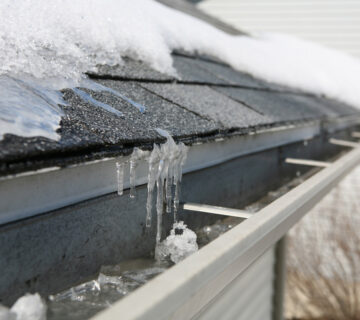The Impact of Water Stains & Spots on Ceilings
Water stains on ceilings are not only unsightly, but they can also indicate serious issues with water infiltration and potential risks to the structural integrity of a building. Our goal is to help you understand the severity of the problem and the potential risks it poses. From identifying the underlying causes to discussing ways to address and prevent further damage, we aim to provide you with valuable insights into dealing with water stains on your ceilings effectively.
Identifying the Underlying Causes of Water Stains on Ceilings
- Leaking Roof: One common culprit that lead to water stains is a leaking roof. This can occur due to damaged shingles, cracked vents, or deteriorated flashing that allows water to seep into your home.
- Plumbing Issues: Another possible cause of water stains is plumbing issues within your walls or ceiling. Leaky pipes, overflowing drains, or faulty bathroom fixtures can all lead to unwanted moisture that manifests as unsightly stains.
- Condensation Buildup: Sometimes, the issue may not be external but rather internal. Poor ventilation in areas like bathrooms and kitchens can result in condensation buildup, which eventually leads to water damage and staining on ceilings.
- Leaking Chimneys: Chimneys can also be a common cause of water leaks. Cracked mortar, damaged flashing, or deteriorated chimney caps can allow water to penetrate and cause stains on your ceiling.
- Faulty Gutters: Gutters that are clogged, damaged, or improperly installed can lead to water overflow. This water can then seep into your home, causing stains on your ceiling and potential structural damage.
Assessing the Severity of Water Damage on Ceilings
- Visible Stains: Identifying water stains on your ceiling is the first step in assessing the severity of water damage. Look out for discoloration, peeling paint, or bulging areas as these are signs of moisture infiltration.
- Texture Changes: Touch the affected area to check for softness or sponginess. A wet ceiling may feel damp or mushy, indicating a more serious issue that requires immediate attention.
- Mold and Mildew Growth: If you notice mold or mildew forming on your ceiling, this is a clear indication of prolonged exposure to moisture. Mold can pose health risks and should be addressed promptly by professionals to prevent further damage.
Recognizing Signs of Serious Water Stains on Ceilings
- Dark Discoloration: Look for dark, spreading stains on your ceiling that indicate water has been leaking for a significant amount of time.
- Sagging or Bubbling: If you notice your ceiling starting to sag or bubble, it could be a sign of water damage causing the paint and plaster to separate from the surface.
- Musty Odor: A musty smell emanating from the area near the stained ceiling can signify mold growth due to prolonged moisture exposure.
If you observe any of these signs in your home, it’s crucial to address them promptly to prevent further damage and potential health risks associated with mold. Ignoring water stains can lead to structural issues and compromise the safety of your living space. Don’t hesitate to seek professional help if you suspect serious water damage in your home.
Importance of Thorough Ceiling Stain Inspection
Inspecting ceiling stains is crucial for identifying potential water damage and addressing underlying issues promptly.
- Early Detection: Thorough inspection can catch water leaks early, preventing further damage to the structure of your home.
- Health Concerns: Water stains can lead to mold growth, which poses serious health risks if left untreated.
- Property Value: Regularly inspecting ceiling stains maintains the value of your property by ensuring that any issues are resolved promptly before they escalate.
Impact of Water Leaks on Ceiling Structural Integrity
Leaks can significantly compromise the structural integrity of your ceiling. When water infiltrates through cracks or gaps, it weakens the materials that support the ceiling, such as drywall or wooden beams. This weakening can lead to sagging ceilings and even pose a safety hazard if left unaddressed.
- Weakening of Materials: Water damage causes materials like drywall to become softer and less sturdy, making them more susceptible to crumbling.
- Mold Growth: Persistent water leaks create a damp environment that fosters mold growth. Mold not only damages the structure but also poses health risks to occupants.
- Potential Collapse: In severe cases, prolonged exposure to water leaks can result in ceiling collapse, posing significant dangers to those below.
Addressing Water Stains on Ceilings: Prevention and Repair
Prevention Tips:
- Regularly inspect the roof for leaks or damage.
- Ensure proper ventilation in areas prone to moisture buildup.
- Fix plumbing issues promptly to prevent water seepage.
- Maintain and clean gutters to prevent water overflow.
- Inspect and repair chimney flashing and caps to prevent leaks.
- Use waterproof sealants on ceilings in high-moisture areas.
Repair Techniques:
- Identify the source of the water stain before attempting any repairs.
- Patch up holes or cracks in the ceiling with a suitable filler material.
- Apply a stain-blocking primer before repainting the affected area.
- Request professional help if the stain is extensive or recurring.
Preventing and addressing moisture stains on ceilings promptly can save you from costly repairs and potential health hazards associated with mold growth. By following these prevention tips and repair techniques, you can maintain a healthy and aesthetically pleasing living environment for yourself and your family.
Urgency of Ceiling Water Stain Repair
- Mold Growth: Water stains on ceilings can serve as breeding grounds for mold and mildew, which pose serious health risks.
- Structural Damage: If left untreated, water stains can lead to structural damage in your home, compromising its integrity.
- Aesthetic Concerns: Unsightly water stains can detract from the appearance of your home and lower its value.
Immediate action is essential when it comes to addressing water stains. Act swiftly to prevent further damage and ensure the safety and well-being of your household. Don’t underestimate the urgency of repairing these stains promptly; the consequences could be far-reaching if neglected.
Understanding the Effects of Ceiling Water Damage
Water stains on ceilings may indicate a more severe problem than just aesthetics. If left untreated, water damage can lead to mold growth, structural weakening, and potential health risks. It is crucial to address ceiling and wall water stains promptly to prevent further damage.
Impact on Health and Safety:
- The presence of water stains on ceilings can create an environment for mold spores to thrive.
- Mold exposure can trigger allergies, respiratory issues, and other health concerns.
- In severe cases, prolonged exposure to mold from ceiling water damage can pose a serious health risk.
Structural Integrity Concerns:
- Water that seeps into ceilings can weaken the integrity of the structure over time.
- This deterioration may compromise the stability of your home or building.
- Ignoring these warning signs could result in costly repairs down the line.
Contacting a Professional Roofing Company
When dealing with water stains and potential water damage on your ceiling, it is always advisable to contact a professional roofing company. They have the expertise to:
- Accurately diagnose the cause of the water stains.
- Provide comprehensive repair solutions to prevent further damage.
- Ensure that all repairs are done safely and effectively.
If you’re a homeowner don’t wait for a roof leak to get worse. Contact a Legacy Roofing & Exteriors today to protect your home and maintain a safe, healthy living environment for you and your family.


